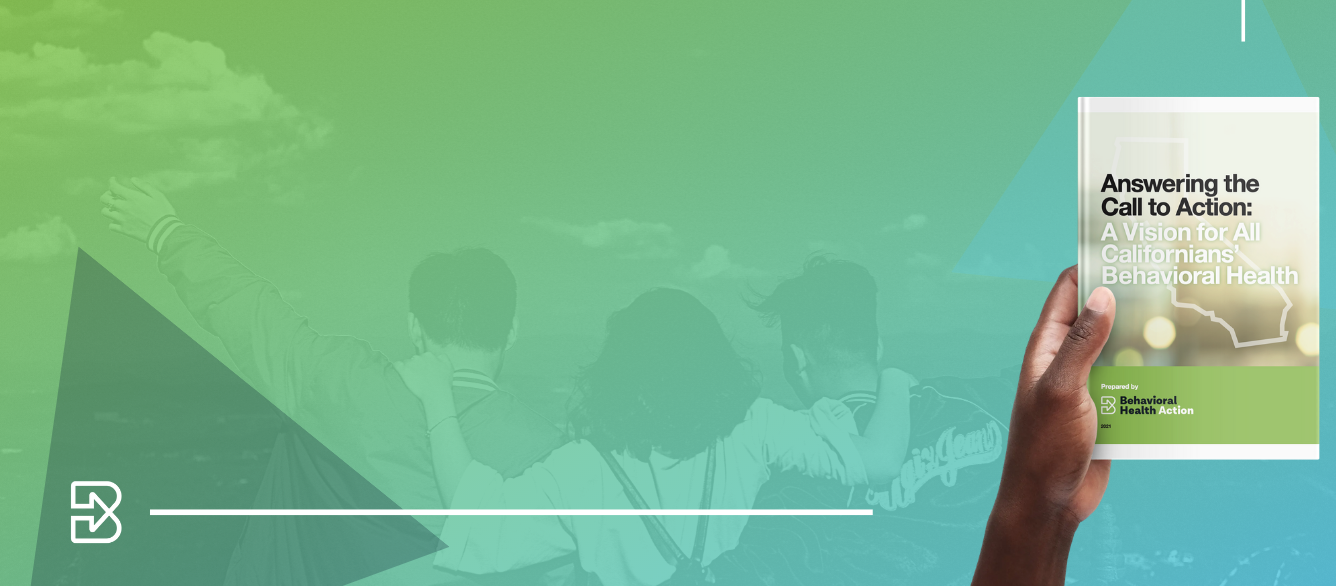Important Additional Considerations
While the proposed standard of behavioral health care in this document is comprehensive, there are several important intersecting issues and challenges that must be tackled alongside our development of a robust continuum of community behavioral health care in California.
Workforce Development
Successful implementation of a robust continuum of care rests heavily on the availability of a sufficient workforce. According to the California Health Care Workforce Commission’s 2019 report:[i]
“As demand grows for quality health care, California does not have enough of the right type of health workers, with the right skills, in the right places to meet the needs of our state’s growing and increasingly diverse population. Despite everything California has done in recent years to improve health care delivery, the state will face a shortfall in the next decade of 4,100 primary care clinicians and 600,000 home care workers and will only have two-thirds of the psychiatrists we need.”
Other findings by the commission include that millions of Californians still don’t have access to quality health care because of where they live, how much they earn, or the health conditions they face.
- Seven million Californians, the vast majority of them Latino, Black, and Native American, live in Health Profes- sional Shortage Areas — a federal designation for counties experiencing shortfalls of primary care, dental care, or mental health care providers.
- Some of the fastest-growing regions of the state, such as the Inland Empire and San Joaquin Valley, have half as many doctors per resident as major metros like the Bay Area.
- In the Northern and Sierra regions, one in five adults say they find it difficult to get the care they need.
- For people who rely on the safety net, these challenges are even greater — with just over half as many doctors accepting Medi-Cal as those who accept private insurance.
- Access to care is a major obstacle for those living with mental illness or drug and alcohol issues.
Additionally, today’s health workforce doesn’t currently reflect the diversity of our state’s population. Given the cost associated with training, it’s no surprise that the majority of medical students in California come from families with incomes in the top 20%. Latinos are now nearly 40% of California’s population, but only 7% of doctors. More than 7 million patients are limited English proficient and could benefit from access to multilingual providers. Yet, the state has only 20% as many Spanish-speaking doctors as it needs.
The workforce gaps for professionals trained to treat children and adolescents is especially acute. According to
the American Academy of Child and Adolescent Psychiatry, there are only 1,135 child and adolescent psychiatrists
in California — a state with over 9 million children and adolescents.[ii] In addition to psychiatrists, other professionals who work with children and adolescents are needed. According to the Behavioral Health Workforce Research Center at the University of Michigan School of Public Health, “psychiatric mental health nurse practitioners can provide many of the same services that psychiatrists provide, including the ability to prescribe medications. Research shows that patient satisfaction with their care has been high.”[iii]
A recent University of California, San Francisco Center for Health Force study states:[iv]
“Persons working in some behavioral health occupations are required to obtain a license from the state in which they practice. Other occupations, such as addiction counselors and peer providers, do not require licensure but may require certification. For example, California requires addiction counselors who work in substance use disorder treatment facilities that are licensed or certified by the state to be certified by one of two certifying bodies accredited by the National Commission for Certifying Agencies. Certification is voluntary for peer providers.”
Most studies of the behavioral health workforce focus on the shortfall of licensed providers, and some also discuss peer providers as an important part of meeting California’s behavioral health needs. Expansions are needed in psychiatry residency, nurse practitioner, master’s in social work, marriage and family therapists, licensed professional clinical counselor, and other graduate and doctoral programs to increase the licensed workforce. However, nearly
all these programs are already running at capacity and cannot keep pace with the anticipated growth in the need for qualified behavioral health staff. In addition, these programs are not equally distributed throughout the state, with many rural areas lacking any graduate or doctoral programs, compounding the workforce challenges in rural areas.
Behavioral health systems should take full advantage of other capable individuals who can meet clients’ needs. For example, too little attention is currently paid to the value of expanding employment opportunities to non-licensed, college educated individuals who hold associate’s, bachelor’s, or master’s degrees in a wide range of disciplines. Additionally, county behavioral health systems should take full advantage of the existing, broad range of provider types eligible to provide billable services to Medi-Cal beneficiaries while working to increase the number of non- licensed individuals and peer providers available to work in behavioral health. These efforts could include creating specialized certifications offered at community colleges, and post-bachelor’s intensive training programs, as well as taking further advantage of existing certification opportunities, such as the Certified Psychiatric Rehabilitation Practitioner credential. These examples would be especially helpful to rural areas given the wider distribution of community colleges and bachelor’s degree granting institutions throughout California.
Housing and Homelessness
The critical role of affordable, safe, and stable housing cannot be overstated. Approximately one quarter of California’s 130,000 homeless individuals are chronically homeless (homeless at least a year or repeatedly). According to the National Alliance to End Homelessness:[v]
“People experiencing chronic homelessness typically have complex and long-term health conditions, such as mental illness, substance use disorders, physical disabilities, or other medical conditions. Once they become homeless — regardless of what immediately caused them to lose their housing — it is difficult for them to get back into housing and they can face long or repeated episodes of homelessness.”
Housing costs and income levels are critical factors. Close to 2 million low-income households in California are spending more than half of their income on housing costs, according to the California Department of Housing and Community Development. While the individuals who are homeless and living with a behavioral health condition have a variety of health care, social service, and income support needs, most current programs and funding streams are not integrated. As a result, accusations among health and social service sectors ensue about which entity has the responsibility to help individuals and “end homelessness.”
Housing challenges and homelessness also affect substantial numbers of children in California. Between 2015 and 2016, 8% of all children under age 6 experienced homelessness. Families experiencing homelessness, whether chronic or episodic, often face other barriers to affordable housing. In California, close to half (44%) of families with children under 18 had a high-cost burden for housing, and one in four (25%) of children under age 6 live in low-income working families.[vi]
Availability of Hospital-Based Care for Those Who Need It
Behavioral Health Action is well aware that in rare cases, individuals living with a behavioral health condition will experience acute episodes that require hospitalization. Whether due to not accessing timely and appropriate outpatient, community-based care, or due to the nature and severity of the illness, some individuals do require the safety and care available only in a hospital setting. While Behavioral Health Action emphasizes again that in most cases, access to a robust continuum of services in the community can prevent the need for hospitalization, we do believe sufficient access to hospitalization is necessary and critical.
In California, psychiatric inpatient hospital services may be provided in a freestanding acute psychiatric hospital or within a psychiatric unit of a general acute care hospital . Both types of hospitals are licensed and certified by the California Department of Public Health and may be certified by the Centers for Medicare & Medicaid Services. Individuals may be admitted to psychiatric inpatient care on a voluntary basis, or on an involuntary basis under the Lanterman-Petris-Short Act of California.
Unfortunately, hospital-level inpatient care for mental illness and substance use disorders is not evenly distributed throughout the state and some counties have no inpatient beds for their residents. In total, there are over 6,700 inpatient psychiatric beds licensed in California — a per capita rate falls below the national average. Close to half (25) of California’s 58 counties have no inpatient psychiatric services available locally.[vii] Chemical dependency recovery hospital beds are in even shorter supply (only 667 beds) and 97% of them are located in Southern California and Los Angeles counties.[viii]
Quality of Care
Behavioral Health Action recognizes the importance of the quality of care that is provided. Merely making each service type available through both private insurance and public programs will not necessarily result in consumer and family satisfaction with and improved functioning from the care they receive. In a journal article summarizing findings on health care quality by the Institute of Medicine, the authors state:
“Despite the availability of outstanding health care in the United States, several independent reports, including the Institute of Medicine’s quality chasm report, found that the gap between the care that patients could receive and do receive is greater than a fissure; it is a chasm. Problems include the underuse, overuse, and misuse of interventions and other errors in care. These problems are found in all types of services (i.e., preventive, acute, and chronic), patient age groups, treatment settings, managed and unmanaged care, and somatic and behavioral health services.”
The Institute of Medicine identifies the following “10 Rules to Guide the Redesign of Health Care”:[ix]
- Care based upon continuous healing relationships. Patients should receive care whenever they need it and, in many forms, not just face-to-face visits. This rule implies that the health care system should be responsive at all times (24 hours a day, every day) and that access to care should be provided over the internet, by telephone, and by other means in addition to face-to-face visits.
- Customization based on patient needs and values. The system of care should be designed to meet the most common types of needs but have the capability to respond to individual patient choices and preferences.
- The patient as the source of control. Patients should be given the necessary information and the opportunity to exercise the degree of control they choose over health care decisions that affect them. The health system should be able to accommodate differences in patient preferences and encourage shared decision making.
- Shared knowledge and the free flow of information. Patients should have unfettered access to their own medical information and to clinical knowledge. Clinicians and patients should communicate effectively and share information.
- Evidence-based decision making. Patients should receive care based on the best available scientific knowledge. Care should not vary illogically from clinician to clinician or from place to place.
- Safety as a system property. Patients should be safe from injury caused by the care system. Reducing risk and ensuring safety require greater attention to systems that help prevent and mitigate errors.
- The need for transparency. The health care system should make information available to patients and their families that allows them to make informed decisions when selecting a health plan, hospital, or clinical practice or choosing among alternative treatments. This should include information describing the system’s performance on safety, evidence-based practice, and patient satisfaction.
- Anticipation of needs. The health system should anticipate patient needs rather than simply reacting to events.
- Continuous decrease in waste. The health system should not waste resources or patient time.
- Cooperation among clinicians. Clinicians and institutions should actively collaborate and communicate to ensure an appropriate exchange of information and coordination of care.
According to SAMHSA, the five questions to be asked to determine the quality of substance use disorder treatment include:[x]
- Accreditation: Has the program been licensed or certified by the state? Is the program currently in good standing in the state? Are the staff qualified?
- Medication: Does the program offer FDA-approved medication for recovery from alcohol and opioid use disorders?
- Evidence-Based Practices: Does the program offer treatments that have been proven to be effective in treating substance use disorders including medication management therapies, such as motivational therapy, cognitive behavioral therapy, drug and alcohol counseling, education about the risks of drug and alcohol use, and peer support?
- Families: Does the program include family members in the treatment process?
- Supports: Does the program provide ongoing treatment and supports beyond just treating the substance issues? Quality programs provide treatment for the long term which may include ongoing counseling or recovery coaching and support and helps in meeting other basic needs like sober housing, employment supports, and continued family involvement.
Ease of Navigation
It is critical to ease the navigation of behavioral health services. Regardless of their health care coverage, individuals and families have a very difficult time finding the type of care they need when they need it. This results in unnecessary stress and frustration, as well as delays in treatment access. It can also discourage individuals and families from seeking help. The stigma surrounding mental health and substance use disorders compounds the difficulties in access because people may be reticent to seek assistance in the first place. While a variety of phone numbers and web sites exist to provide information and resources to individuals seeking behavioral health care, no single place exists for individuals, families, and providers to obtain help navigating the web of behavioral health care available in each community/county.
Outcomes Evaluation
Efforts to evaluate the effectiveness of California’s behavioral health services are sorely lacking in statewide infrastructure, investment, and technical expertise/assistance. Establishing a select number of standard client-level outcomes for measurement by all behavioral health care systems and providers would assist with accountability and public transparency, as well as helping facilitate better treatment and policy decision making.
Current state law already requires several state agencies to evaluate mental health and substance use disorder services. However, none of the existing efforts provide a clear conclusion about whether individuals being served are getting healthier. Most of the data currently collected are reported in a program-by-program fashion and are not assembled at the state level to reach conclusions about the point-in-time or long-term performance trends of programs, counties, Medi-Cal managed care plans, health plans, or the state.
Special Populations
Finally, Behavioral Health Action recognizes there are a number of important special populations that should be considered by policy makers based on their high risk factors and difficulties accessing adequate behavioral health and primary care services. Examples include, but are not limited to:
- Older adults, including individuals with dementia or Alzheimer’s disease
- Individuals with traumatic brain injuries
- Individuals receiving conservatorship, guardianship services, or who are detained involuntarily for evaluation due to danger to self or others or grave disability due to a mental disorder
- Individuals with co-occurring intellectual/developmental disabilities
- Youth and families involved in the child welfare or juvenile justice systems
- Immigrants, refugees, and their children
- Infants and young children, birth to 5 years of age
- People from unserved/underserved/inappropriately served communities including racial, ethnic, and LGBTQ communities
Citations:
[i] California Future Health Workforce Commission, “Meeting the Demand for Health: Final Report of the California Future Health Workforce Commission,” February 2019, https://futurehealthworkforce.org/wp-content/uploads/2019/03/MeetingDemandForHealthFinalReportCFHWC.pdf
[ii] American Academy of Child and Adolescent Psychiatry, “California: Child and Adolescent Psychiatrist (CAP) Workforce Distribution Map,” 2018, https://www.aacap.org/app_themes/aacap/docs/Advocacy/federal_and_state_initiatives/workforce/individual_state_maps/Califor- nia%20workforce%20map.pdf
[iii] National Academies of Sciences, Engineering, and Medicine, “Training the Future Child Health Care Workforce to Improve Behavioral Health Outcomes for Children, Youth, and Families: Proceedings of a Workshop— in Brief, 2017, https://doi.org/10.17226/24789
[iv] Janet Coffman, Timothy Bates, et. al, “California’s Current and Future Behavioral Health Workforce,” Healthforce Center at UCSF, February 2018, https://healthforce.ucsf.edu/sites/healthforce.ucsf.edu/files/publicationpdf/California%E2%80%99s%20Current%20and%20Future%20Behavioral%20Health%20Workforce.pdf
[v] National Alliance to End Homelessness, “Chronically Homeless,” 2019, https://endhomelessness.org/homelessness-in-america/ who-experiences-homelessness/chronically-homeless/
[vi] Ibid
[vii] California Hospital Association, “California’s Acute Psychiatric Bed Loss,” February 2019, https://www.calhospital.org/sites/main/files/ file-attachments/psychbeddata2017.pdf?1555456346
[viii] California Health and Human Services Agency, Open Data Portal, https://data.chhs.ca.gov/
[ix] Institute of Medicine Committee on Quality of Health Care in America, “Crossing the Quality Chasm: A New Health System for the 21st Century,” 2001, https://www.ncbi.nlm.nih.gov/books/NBK222277/
[x] Substance Abuse and Mental Health Services Administration, “Finding Quality Treatment for Substance Use Disorders,” 2018, https:// store.samhsa.gov/system/files/pep18-treatment-loc.pdf


